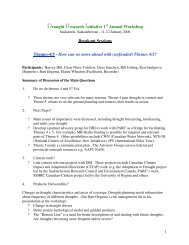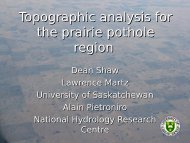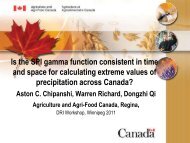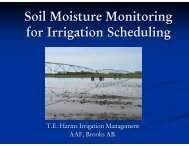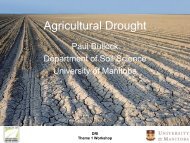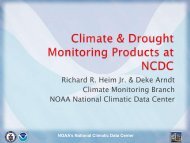Modelling soil moisture with the VIC model during drought (Lei Wen)
Modelling soil moisture with the VIC model during drought (Lei Wen)
Modelling soil moisture with the VIC model during drought (Lei Wen)
You also want an ePaper? Increase the reach of your titles
YUMPU automatically turns print PDFs into web optimized ePapers that Google loves.
Modeling Soil Moisture <strong>with</strong> <strong>the</strong><strong>VIC</strong> Model During Drought<strong>Lei</strong> <strong>Wen</strong> 1 , Charles A. Lin 1,2 , John Pomeroy 31 23
1. <strong>VIC</strong> prairie <strong>soil</strong> <strong>moisture</strong> <strong>model</strong>ing• three <strong>soil</strong> layers (0-20 cm, 20-100 cm, 0-100 cm), 0.25 ° x0.25 °, dailytime step• starting on 1 January, 1950, real-time forecasting <strong>with</strong> a lead time up to 35-day• meteorological forcing: 1,167 stations + operational Canadian GEM forecast +operational 40-number super ensemble forecast + operational CMC ensembleseasonal forecast• <strong>VIC</strong> <strong>soil</strong> <strong>moisture</strong> + its 60-yr climatology (1950-2009) calculating a <strong>soil</strong><strong>moisture</strong> index SMAPI (Soil Moisture Anomaly Percentage Index)• <strong>VIC</strong> SMAPI compares favorably <strong>with</strong> three independent <strong>drought</strong> datasets, canexplain historical <strong>drought</strong> events in <strong>the</strong> Prairies• <strong>VIC</strong> <strong>soil</strong> <strong>moisture</strong> is updated daily at present; SMAPI results are publiclyaccessible online (http://www.meteo.mcgill.ca/~leiwen/vic/prairies/)
1,167 met stations (black dot) on <strong>the</strong>Prairies4393 grid points, 0.25 ° x 0.25 °Flat terrain and non-contributingdrainage areas, which bringschallenges to hydrological <strong>model</strong>ing
5 additional validationcatchments in red7 calibrationcatchments in green;<strong>VIC</strong> calibration and validation6 <strong>moisture</strong>sites‣ We calibrate <strong>the</strong> six <strong>VIC</strong> user-calibrated hydrologicalparameters using observed daily hydrographs at <strong>the</strong> outlets ofeach of <strong>the</strong> 7 calibration catchments.‣ The validation of <strong>the</strong> calibrated <strong>VIC</strong> over <strong>the</strong> Prairies involves<strong>the</strong> following three parts.1. First, we validate <strong>VIC</strong> using observed daily hydrographs from<strong>the</strong> same 7 calibration catchments taken over different periodsthan for calibration.2. Second, we fur<strong>the</strong>r validate <strong>VIC</strong> using observed dailyhydrographs from 5 additional catchments.3. Third, we compare simulated <strong>soil</strong> <strong>moisture</strong> anomalies <strong>with</strong> in situobservations from 6 Alberta sites.We define 7 <strong>VIC</strong>simulation regions over <strong>the</strong>Prairies, which is based on<strong>the</strong> annual precipitation of1950-2009
2. <strong>VIC</strong> <strong>soil</strong> <strong>moisture</strong>60-yr (1950-2009) average of <strong>soil</strong> <strong>moisture</strong> (top 1-m) over <strong>the</strong> Prairies<strong>with</strong> <strong>the</strong> 200 mm <strong>soil</strong> <strong>moisture</strong> contour, showing <strong>model</strong>ed very dry areas200 mm is <strong>the</strong> <strong>VIC</strong>average wilting pointIdentifications of <strong>the</strong> Palliser Triangle region and <strong>the</strong> Prairie Dry Belt (Jones, 1978) in South Prairies.
DRI periodSoil <strong>moisture</strong> deficit of twoperiods <strong>with</strong> respect to <strong>the</strong>60-year climatology:• 1999-2005 (top)• 2001-2002 (bottom)
3. Soil Moisture Anomaly Percentage Index (SMAPI)FrequencySMAPI100%• The <strong>soil</strong> <strong>moisture</strong> climatology reflects local characteristics and mirrors <strong>the</strong> hydrometeorologicalphenomena of a region• Applying <strong>the</strong> concept of relative <strong>soil</strong> wetness for measuring <strong>drought</strong> severity• Keyantash and Dracup, BAMS, 2002 (second highest ranking among <strong>the</strong> five evaluatedindices for agricultural <strong>drought</strong>)Drought classifications based on SMAPI0.300.250.200.150.100.05HarbinXifengzhenHaihongJinzhouZhumadianXuzhouSuxianZhenjiangJinjiangBaiseAverage0.00-60 -50 -40 -30 -20 -10 0 10 20 30 40 50 60SMAPI(%)
Reconstructing prairie <strong>drought</strong> historySou<strong>the</strong>rn Saskatchewan, April 2002;Taken from StewartExampleDaily SMAPIdistributions of <strong>the</strong>three <strong>soil</strong> layers forApril 20, 2002,toge<strong>the</strong>r <strong>with</strong> <strong>the</strong>April-2002 average
Annual SMAPI for <strong>the</strong> period of 1997-2005
4. Comparing SMAPI <strong>with</strong> three datasetsa. North American Drought Monitor (NADM)NADMSMAPI
NADM from Richard Rieger, Agriculture and Agri-Food Canada
<strong>VIC</strong> SMAPI, June 30, 2009<strong>VIC</strong> SMAPI, June-2009 average
. National Drought Indice (PDI) of Agriculture and Agri-Food CanadaLocations of PDI stationsDry regionWet region
c. Environment Canada PDSIhttp://www.meteo.mcgill.ca/~leiwen/vic/prairies/month-seasonalannual/index_compare.htmlFor <strong>the</strong> period 1950-2005 (monthly)
Monitoring andforecasting Winnipeg2009 flooding
Real-time <strong>drought</strong>forecasting <strong>with</strong> alead time up to 35-d
35dReal-time China <strong>drought</strong> forecastForecast verifying on April 4, 2010 <strong>with</strong>different lead time25d15d4dMonitoring(Drought Monitor,China MeteorologyAdministration
Thanks very much !Merci beaucoup !



